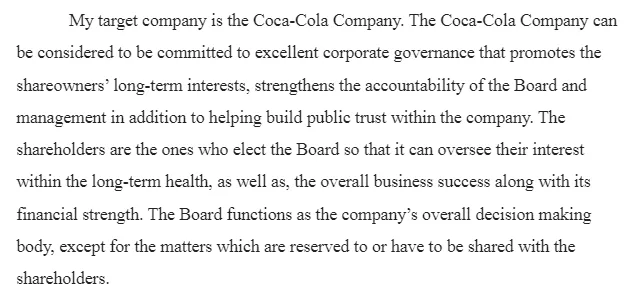Organizational Governance Mechanisms
To support your work, use your course and text readings and also use outside sources. As in all assignments, cite your sources in your work and provide references for the citations in APA format.
Governance mechanisms are considered to be effective if they meet the needs of all stakeholders, including shareholders. Governance mechanisms are also an important way to ensure that strategic decisions are made effectively. As a potential employee, how would you go about investigating a firm’s governance structure? Would that investigation weigh in your decision to become an employee?
Identify a firm that you would like to join or one that you just find interesting. Complete the following research on your target firm:
Find a copy of the company’s most recent proxy statement and 10-K. Proxy statements are mailed to shareholders prior to each year’s annual meeting and contain detailed information about the company’s governance and present issues on which a shareholder vote might be held. Proxy statements are typically available from a firm’s website (look for an “Investors” submenu). You can also access proxy statements and other government filings such as the 10-K from the SEC’s EDGAR database.
Click here to access SEC’s EDGAR database.
Alongside the proxy, you should also be able to access the firm’s annual 10-K. Here you will find information on performance, governance, and the firm’s outlook, among other things.
- Identify one of the company’s main competitors for comparison purposes. You can find this information using company analysis tools such as Datamonitor.
Some of the topics that you should examine include:
- Compensation plans (for both the CEO and board members; be sure to look for any difference between fixed and incentive compensation)
- Board composition (for example, board size, insiders and outsiders, interlocking directorates, functional experience, how many active CEOs, how many retired CEOs, what is the demographic makeup, age diversity, and so on)
- Committees (how many, composition, compensation)
- Stock ownership by officers and directors—identify beneficial ownership from stock owned (you will need to look through the notes sections of the ownership tables to comprehend this)
- Ownership concentration—evaluate the firm’s outstanding stock owned by institutions, individuals, and insiders and identify the no. of large-block shareholders (owners of five percent or more of stock)
In addition, answer the following questions:
- Does the firm utilize a duality structure for the CEO?
- Is there a lead director who is not an officer of the company?
- What are the activities by activist shareholders regarding corporate governance issues of concern?
- Are there any managerial defense tactics employed by the firm? For example, what does it take for a shareholder proposal to come to a vote and be adopted?
- What is the firm’s code of conduct? List them.
Prepare a double-spaced memo summarizing the results of your findings with a side-by-side comparison of your target and its competitor. Your memo should include the following topics:
- Summarize what you consider to be the key aspects of the firm’s governance mechanisms.
- Attach to your memo a single graph covering the last 10-year historical stock performance for both companies. If applicable, compare both using a representative index such as the Standard & Poor’s (S&P), National Association of Securities Dealers Automated Quotation (NASDAQ), or other applicable industry index.
- Highlight key differences between your target firm and its competitor.
- Based on your review of the firm’s governance, discuss any change in your opinion of the firm’s desirability as an employer. How does the competitor stack up, governance wise? Why or why not?
Answer Preview-Organizational Governance Mechanisms

